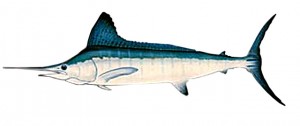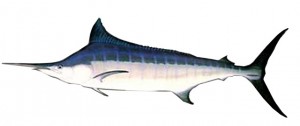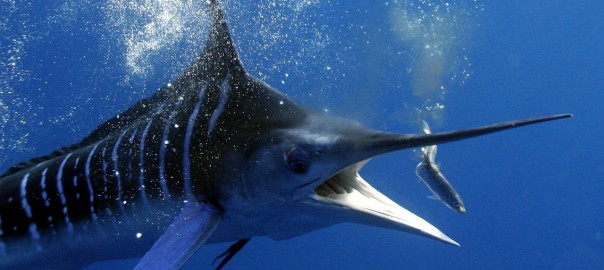Marlins, also known in The Canary Islands as billfish, are the indisputable kings of big game fishing we were taking about in our previous article. These species reach our coasts while migrating, foraging, searching for breeding areas (they spawn in Summer and Autumn) and warm waters.
But they aren’t just fishers’ dreams, but many tourists, in their boat tours, have had the chance to enjoy the majesty of watching them jump on our waters surface.
As we promised, here is some information about the two Marlin species that, with the elegance that characterises them, visit our island.
The White Marlin
Tetrapturus Albidus, or Spikefish as many call them, belong to the Istiophoridae family (tetrapturus genus).

They are greenish-blue or greyish on their back, and their belly is white. Their body is striped.
Their average weight is 30kgs, and you can find up to 100kgs specimens although nowadays it’s becoming harder and harder to find huge specimens due to illegal and devastating fishing habits (catching young fish, not letting them grow up). Their average length is 200 cms, although you can find up to 300cms long specimens, and they reach maturity when they are around 130cms long.
They live in warm seas, deep waters, although they also approach the coast up to 20 mts deep. They don’t usually travel in school, but just in couple or alone. They are characterised by their nose bones on their upper jaw, which stretch in the shape of a long round sword, which favours their hydrodynamics.
They have a rigid tail in the shape of C, and a high rear fin, characteristic of this species.
They feed on squids and small fish, and they spawn in the high seas.
The White Marlin is one of the most popular fishes in big game fishing in the Atlantic Ocean. In the Canary Islands we usually have them in Summer.
The Blue Marlin
Makaira nigricans or Atlantic Blue Marlin, also belongs to the Istiophoridae family (makaira genus).

It’s known as one of the most elegant and beautiful in the Ocean, and also one of the biggest fishes.
In this species, the females are the biggest, reaching 4,5mts long and more than 800kg, although the average is about 3,5m and among 90 and 180kg the males. There are different opinions regarding the years they may come to live, but they are believed to live around 20 years. Their characteristics are similar to the white Marlin’s, with a high rear fin and a long and lethal upper jaw they attack their prey with, leaving them injured and shocked, moving backwards and then eating them.
Their back is cobalt blue, and their belly is silvery white. They spend most of their time off-shore (pelagic species) and this is why they are known as blue water fish, following the ocean currents while migrating for hundreds and even thousands of miles, after tuna fish schools (tuna, dorado, mackerel…), on what they feed in warm and shallow waters, although they also plunge into the depths foraging cephalopods.
They are quick swimmers (up to 110km/h), swimming 50m in two seconds, a distance that men couldn’t swim in less than 29 seconds and one of the noblest species in the fisheries world as they are remarkably resilient to be caught and you can see them jump and swim swiftly trying to get ride of hooks, and they are often successful. Their meat is delicious and it is marketed in a professional way, mainly in Japan, where they live in the shape of sashimi, although in big game fishing it is usual to catch them and then let them go. However their preservation is in danger due to non sustainable fishing practices mainly in the Atlantic.
From Fuertecharter we recommend making boat tours around our coasts, mainly in the South, to everyone who may have the chance to do it and see if they are lucky to catch sight of one of this marvellous specimens living in our waters.
FuerteCharter’s Team
